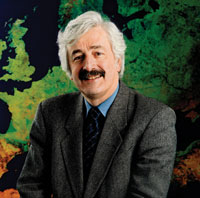
ERCIM News 65April 2006Special theme: Space Exploration Contents This issue in pdf Subscription Archive: Next issue: July 2006 Next Special theme: |


by David Southwood,
Director of Science, European Space Agency
Once upon a time there used to be a bumper sticker that said “If you can read this ... thank a teacher.” In the 21st century as we land probes on remote parts of our solar system, drop into orbit around Venus or Mars or deliberately crash into the Moon, one should acknowledge that “If you have got here ... thank an IT guy.” We take so much for granted. Rockets which can get us off the planet are now more than half a century old, telecom and navigation systems are more than forty and man landed on the Moon just under 40 years ago. Back then we expected to have built lunar colonies and be arriving at Mars by now. It is a commonplace to say that we were wrong but it is less common to stand back and just look at what has happened and what we have had that we never expected. The advances have largely been due to those IT folks.
The capabilities offered by IT systems and modelling have changed our world and what we can do to understand it and indeed to leave it much more than gaining the simple ability to get off the planet. Last year ESA landed the Huygens probe on Titan. To my utter incredulity we saw radio telescopes across the Earth directly pick up the signal from a transmitter 10 times further from the Sun than us and about as powerful as a terrestrial mobile phone. The world held its breath as ‘ET phoned home’. But it was not the phone, it was software sophistication, mathematical ingenuity and computer power which got that signal out of the background.
However it was also simulation and modelling that got the probe safely down on a surface that had never been directly seen. Landing the baby on Titan had also involved an enormous amount of computing and modelling work in advance. One had an idea (and so a model) of the Titan atmosphere from the Voyager spacecraft flyby more than twenty years before. Otherwise, the latest information only arrived from the first Cassini spacecraft flyby just under three months before landing and two months before release from the mother ship – when targeting would be fixed. Simulation and modelling played a key role in making that a much more secure process.
The last decade’s revolutions in computing, simulation and information have paid off for our exploration of what lies beyond our solar system as well. Here my favourite example is the GAIA mission, whose industrial build phase we have just kicked off in the last few months. Most simply expressed the purpose of the mission is counting the stars in the sky. It will find very accurately the position and then the motion as well as the colour of 1 billion stars within our own galaxy, the Milky Way. It is a grand mission and tackles a grand problem – where did our galaxy come from and how will it evolve? It is going to allow us to ‘deconstruct’ our galaxy and to examine nature’s clockwork in detail. This is a space mission that certainly requires very sophisticated optical systems and detection systems but which is made possible only by the advance of information technology, mathematical modelling, simulation and data processing. The megabytes of data continuously fed down every second over the five year life will have to be built into an enormous data mountain to be mined for years to come but that mountain has to be put together properly in the first place by careful and efficient processing. In other words informatics and mathematics are the key to success. I for one would say thank you to the IT people. With you, we are doing things we could only have dreamed of even at the dawn of the space age. You are determining our future and helping open up our horizons.